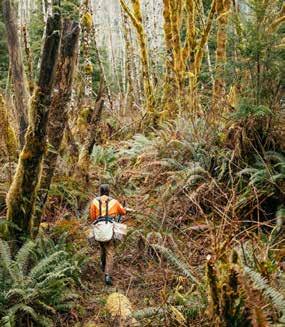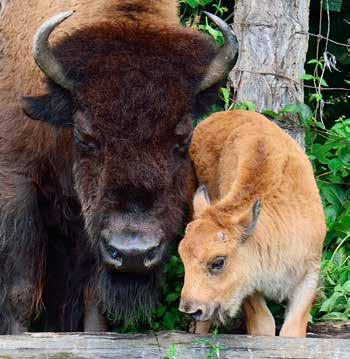

Future of Our Planet


What strategic priorities has the Ministry of Natural Resources Canada outlined for the year 2024?
This year, my goal is to fight climate change while making life more affordable for Canadians. To that end, my four priorities for 2024 are:
1. Creating sustainable jobs and industries
The transition to a net-zero emissions world must be people-focused. Canadian workers will lead this shift, with both skills they already have and skills they can acquire. That is why, in 2024, we're working to pass the Sustainable Jobs Act. This Act establishes a framework that centres around workers and communities, so that, no matter where you work, you benefit from the generational opportunity of a net-zero economy. Through the
Regional Energy and Resource Tables, we're also are working directly with each province and territory on the issues that matter most to their economy and their citizens, to create opportunities and jobs for Canadians in every region of the country. In 2024, I'm focused on continuing to work with provinces and territories, workers, unions, and companies across the country to make sure every Canadian has access to a well-paying, sustainable job.
2. Reducing energy bills
Climate change is costly - not just for the environment, but for your wallet. We know that one of the fastest, cheapest ways to fight climate change and slash the costs of energy bills is to undertake home retrofits, like a installing heat pump, or new windows. The Government of Canada has a host of programs to help families do just that,
including the Oil to Heat Pump Affordability Program, the Canada Greener Homes Loan, and a soon-to-be announced second phase of the popular Canada Greener Homes Grant.
3. Preparing for upcoming wildfire, flood, and hurricane seasons
In 2023, Canadians faced the worst wildfire season in recorded history. Fighting these fires cost over $1 billion — a 60 per cent increase to the annual average. Scientists estimate this could continue to increase by hundreds of millions of dollars, if we don't take action to prepare properly and address climate change. 2023 showed us the costs that failure to act on climate change would bring to our health, environment, economy, and communities. In 2024, we’re investing millions of dollars to train and outfit firefighters across the country. We’re also
accelerating our efforts to reduce the risk of climate-related disasters, improve health outcomes, protect nature and biodiversity, and build and maintain resilient infrastructure.
4. Installing more EV chargers
In 2035, all new vehicle sales in Canada will be electric. But every one of those cars needs a place to plug in, and we know that range anxiety is real. That's why we're investing over $1 billion in charging infrastructure and building a coast-to-coast network of chargers in all areas where Canadians live, work, and play. We have already announced funding for over 45,000 public charging stations to date, with tens of thousands more to come in 2024 and beyond, especially for rural and remote areas.
Bilas

TPlanting a Greener Future: Tree Canada’s Reforestation Projects
Deforestation jeopardizes Canada’s climate and biodiversity. Tree Canada combats this threat by planting trees for a more sustainable future.
Veronica Stephenson
climate change through the deceptively simple act of tree planting.
Planting trees is a cheap, effective strategy to tackle climate change.
he loss of forest cover poses a critical threat to the integrity and biodiversity of Canada’s environment, compromising vital habitats and exacerbating climate change. That’s where Tree Canada comes in.
It’s Canada’s sole non-profit organization dedicated to planting trees in every province, and in both urban and rural environments.
Their mandate isn’t just about
“Planting trees is a cheap, effective strategy to tackle climate change,” says Randall Van Wagner, Head of the organization’s National Greening Program.
“Trees sequester carbon and produce oxygen, have a cooling effect, and protect our ecosystems by providing much-needed habitat for threatened and endangered species.”
Planting the right trees in the right places
Native trees have adapted to particular conditions over the course of their evolution. Tree Canada takes the natural
where they align with the local environment. Choosing the right trees for each planting project enhances biodiversity and contributes to the sustainability of Canada’s stunning natural landscapes.
Rooted in partnership
Collaboration is the keystone of Tree Canada’s operations. The organization works with everyone from retired foresters and corporate sponsors to Indigenous communities, all of whom play a vital role in bringing projects from conception to execution.
The non-profit recently entered an historic partnership with the Northwest Territories’ Tłı̨ chǫ Government to plant one million trees over the next three years in areas devastated by wildfires. It’s the largest reforestation project in the history of the Northwest Territories
The Urgent Need to Protect Canada's Forests
Consumers can help to protect Canada's forests by choosing responsibly sourced wood and paper products bearing the Forest Stewardship Council label.
Monika Patel, Forest Stewardship Council (FSC) Canada

Canada's vast forests, which cover nearly 400 million hectares, make up 10 per cent of the world's forests. Still, our national canopy is threatened and consistently at risk. Over the years, our tree cover has plummeted by 11 per cent, endangering biodiversity and exacerbating the climate crisis.
Monika Patel Director of Communications and Marketing, Forest Stewardship Council (FSC) Canada
The news cycle demonstrates in real time our close relationship with forests, with wildfires in 2023 ravaging communities in British Columbia and Quebec, impacting air quality as far away as Toronto.
At stake is the loss of diverse wildlife, Indigenous communities, and carbon storage, which helps in avert-
ing the climate crisis. Protecting our forests is a role that isn’t exclusive to activists or governments — it’s a role any consumer can take on, through their choices.
Stand for forests
Enter the Forest Stewardship Council (FSC), which works to protect animal habitats, Indigenous Peoples’ rights, workers’ rights, and areas of environmental or cultural importance.
The FSC does this by tracking fibre from certified forests along the entire supply chain all the way to the store — where consumers are then empowered to be part of the sustainability solution by selecting wood, paper, and other forest products bearing the FSC label.
Supported by leading environmental groups including WWF Canada and the Canadian Parks and Wilderness Soci ety (CPAWS), these labels provide consumers with an assurance that the products are made from responsible sources and have been verified to meet the FSC’s strict environmental and social standards. This article was sponsored by the Forest Stewardship Council




Visit treecanada.ca to help restore land affected by wildfires and reforest areas in need across Canada.
This article is sponsored by Tree Canada.
Randall Van Wagner Head of Tree Canada’s National Greening Program
From Seed to Healthy, Resilient Forest
Creating and restoring healthy forests requires the right seed, from the right source, planted in the right place.
Jess Kaknevicius, CEO, Forests Ontario and Forest Recovery Canada
The United Nations International Day of Forests (March 21) was created to celebrate and raise awareness of the importance of forests. At Forests Ontario, we've worked hard to build strong relationships with a comprehensive network of experienced partners who understand the transformative power of healthy forests. This includes everything from partners who are growing and planting new trees, to those who manage and maintain the health of our forests, to those who educate and train the next generation of forest stewards.
The need for seed
After working with our partners over the years to plant approximately 43 million trees and being named an official Restoration Implementer of the United Nations Decade on Ecosystem Restoration, we're proud to be a trusted authority for those seeking to invest in
the growth, resiliency, and future of our forests. During all that time planting trees, we've learned a simple truth: it all starts with high-quality, source-identified tree seeds. If we don’t have seed, we can’t grow trees — and we need a lot of seed to be able to continue to plant the millions of trees we do with our partners each year.
We need to invest in seed so we can restore our existing forests and grow healthy, resilient, new forests for generations to come.

Currently, Forests Ontario has over 204 million viable seeds in storage to ensure we will always have a reliable source to produce the trees for our large-scale planting projects. The trees and shrubs grown from those seeds are resilient, native varieties that will support biological diversity and increase habitat for wildlife, help combat the impacts of climate change, and improve the health and longevity of our forests. By paying close attention to seed every step of the way from collection to growth to
The Future Is Plant-Based — and You Can Help Lead the Way
The sooner we shift to plant-based eating, the sooner we’ll create a much, much better world.
Earthsave Canada
Plant-based eating has become increasingly popular in recent years, and it’s easy to understand why. Faced with an obesity epidemic, a climate crisis, and even a global pandemic, many people are looking for ways to make meaningful change to support the future of our planet.
Plant-based eating is a uniquely powerful individual choice that has tremendous positive effects for personal health, environmental sustainability, and reducing the number of animals subjected to horrific suffering and death.
From the recent Canada Food Guide to the EAT-Lancet report to the Drawdown Review, experts around the world recognize the importance of shifting to plant-based diets.
The benefits of plant-based eating
By eating plant-based, you’ll be helping to address climate change, air and water pollution, deforestation, and global hunger. You’ll also be adding years to your life and life to your years! Studies have shown that the risks of heart disease, type 2 diabetes, ischemic stroke, and some types of cancer are all substantially lower in people eating largely plant-based diets.
planting, we can evaluate seed quality and monitor how they perform in the nursery and on the landscape, informing critical decisions on sourc ing high-quality seed that will produce healthy, resilient forests in our urban and rural communities.

Especially now, after we saw wildfires rage throughout Canada and around the world last year, we need to invest in seed so we can restore our existing forests and grow healthy, resilient, new forests for generations to come.
As we celebrate International Day of Forests this month, don’t forget that the forests we're celebrating all started with a seed.
Visit forestsontario.ca to see how you can help.


You’ll also be shifting your support from industries that inherently cause animal abuse and suffering on an unfathomable scale to those that produce the foods keeping us healthiest: fruits and vegetables, whole grains, beans, legumes, nuts, and seeds.
Far from being restrictive, moving toward plant-based eating
today is easier than ever, and it can open up a world of culinary possibilities and reignite a love for food that nourishes your body. Start making your shift today!
Far from being restrictive, moving towards plant-based eating today is easier than ever.

This article is sponsored by Forests Ontario.
Jess Kaknevicius CEO, Forests Ontario and Forest Recovery Canada
How Plant-Based Foods Can Power a Healthier Future for Our Planet
The plant-based food sector has the potential to significantly lower the agriculture sector’s climate impact, and Protein Industries Canada enables its innovation.
Tania Amardeil
Agriculture has an impact on our planet — but it’s not necessarily a negative one.
“Our food systems account for around 20 per cent of global greenhouse gas emissions,” says Bill Greuel, CEO of Protein Industries Canada. Despite this considerable effect, the biological systems that underpin the agriculture sector can also be a solution to the climate crisis. As an industry-led, not-for-profit organization, Protein Industries Canada manages a government innovation fund to accelerate this sustainability advancement and the competitiveness of the Canadian value-added agriculture and plantbased food sector.
Reducing carbon intensity along the entire value chain
As Greuel explains, the use of diversified crop rotations and new farming technologies and innovations make all the difference in reducing the sector’s climate impact.
“Pulse crops are unique in that they require little to no synthetic nitrogen fertilizer, which is a major
contributor to emissions,” says Greuel. “Diversified crop rotation — growing peas, lentils, fava beans, chickpeas, and soybeans — plus new farming technologies that help sequester carbon such as zero tillage and minimum tillage and innovations such as the use of coatings on fertilizer all help to reduce agriculture’s environmental impact.”
Providing consumers with alternatives to traditional meat, dairy, and eggs is another way to reduce our food system’s impact, says Greuel, adding that this is why investing in plantbased foods is so important.
“At Protein Industries Canada, we invest in innovative projects directly with private-sector companies to help them with challenges that they're facing or to capture opportunities in the plant-based food and ingredient space,” explains Greuel. Protein Industries Canada uses a value chain approach to innovation, working with everyone from genetics companies to digital agriculture companies to ingredient manufacturers.
Lowering
At Protein Industries Canada, we invest in innovative projects directly with private-sector companies to help them with challenges that they're facing or to capture opportunities in the plant-based food and ingredient space.
agriculture’s climate impact
One of the innovative companies
that Protein Industries Canada has partnered with is AGT Food and Ingredients, a value-added processor of pulses and staple foods headquartered in Regina, Sask.
“When we look at how we grow crops and how we optimize and increase yields with the same amount of input, we can see how agriculture’s carbon intensity is going down,” says Murad Al-Katib, Founder, President, and CEO of AGT Food and Ingredients, a company that mechanically separates pulses’ components — protein, starch, and fibre — and develops innovative uses for them, turning them into ingredients that the food industry can use to achieve nutritional, functional, and other benefits.
“As a sector, we have the ability to solve multiple problems of the world, which include available protein, available food supply, and protein deficiency.”
Alternative protein sources drive climate resiliency and sustainability, and partnerships like the ones fostered by Protein Industries Canada — which prioritize collaboration, diversity of ideas, nimbleness, innovation, and research institutions’ strengths being augmented by strong commercialization — are powering a more sustainable agriculture industry in Canada.



This article is sponsored by Protein Industries Canada

Bill Greuel CEO, Protein Industries Canada
Murad Al-Katib Founder, President, & CEO, AGT Food and Ingredients
Conservation Biobanking at Toronto Zoo
Long-term storage of living genetic material in conservation biobanks provides wildlife population managers with additional tools to support species recovery initiatives.
Did you know that all wood bison born at your Toronto Zoo since 2009 were the result of Assisted Reproductive Technologies (ARTs) and that the sperm used to create most of them were frozen and stored at -196 °C in our biobank?
In general, a biobank is a repository for the long-term storage of biological material. At your Toronto Zoo, the biobank is composed of cryogenically frozen living cells — including sperm, oocytes, embryos, and somatic cells — that can be used to produce offspring, such as the wood bison calves.
Biobanking is a powerful tool for species conservation. As a signatory country to the Kunming-Montreal Global Biodiversity Framework, Canada committed to developing strategies to implement the four goals and 23 targets outlined in the framework aimed at addressing the

biodiversity crisis we now face. One of the targets specifically calls for the need to maintain and restore genetic diversity, a fundamental requirement for healthy, thriving populations. Genetic preservation is one of the most impactful aspects of a biobank.
The vision of the biodiversity framework is a harmonious relationship between humans and nature by the year 2050. But until then, while we’re working to turn things around, biodiversity will continue to decline. With the addition of biobanking to the conservation toolbox, we can effectively slow the loss of genetic diversity, protect it until conditions are favourable, and reintroduce it when the time is right to build healthy, genetically diverse populations.
Canada's Wood Bison
The product of over-hunting and human imported disease, wood bison are listed as Threatened and face significant challenges to their recovery. Your Toronto Zoo Reproductive Sciences team, in collaboration with the Bison Integrated Genomics (BIG) project, have spent the last 15 years developing ARTs to:
• Cryopreserve gametes from remaining herds.
• Develop technologies to produce calves using frozen gametes, including artificial insemination (AI) and embryo transfer (ET).
• Disinfect gametes from diseased herds to restore gene flow between diseased and non-diseased herds.
Your Toronto Zoo has been instrumental in key project advancements:
• Calf born following AI using sperm frozen for 35 years — the oldest known record for a wild species.
• Female calf born following AI using sex-sorted sperm — the first attempt in this species.



Head to wildlifeconservancy.ca to support conservation efforts at your Toronto Zoo. This article was sponsored by the Toronto Zoo
The Salvation Army Thrift Store Encourages Canadians to Make the Shift to Thrift
Donating pre-loved items and thrift shopping are impactful ways to contribute to environmental sustainability while supporting local communities.
Tania Amardeil
In a world grappling with the environmental impact of fast fashion, the need for sustainable practices has never been more pressing. A recent study by Environment and Climate Change Canada reveals that of the estimated 1.3 million tonnes of used apparel generated annually in Canada, a staggering 76 per cent ends up in landfills. Now, more than ever, is the time to take action and embrace more sustainable habits like shopping thrift and donating regularly. In this narrative of conscious con sumerism, The Salvation Army Thrift Store offers not just an alternative to extend the life cycle of pre-loved items but a tangible way for Can adians to make a positive impact on both the environment and their local communities.
“When Canadians choose to donate or shop at our Thrift Stores, they’re always making a profound impact on the lives of our neighbours in need while contributing to the cir cular economy and preserving the planet,” says Dan Kinsey, National Dir ector of Distribution and Recycling at The Salvation Army Thrift Store.
Helping Preserve the Planet, One Donation at a Time
Last year alone, we diverted over 87 million pounds of clothing and household goods from local landfills.


tions rehabilitation, and emergency disaster services.
Celebrating Earth Day
Donating clothing and household items you no longer want or need to The Salvation Army Thrift Store becomes a meaningful act with both real and measurable impacts. “Last year alone, we diverted over 87 million pounds of clothing and household goods from local landfills,” says Kinsey. “We make
The organization encourages Canadians to act now and make a meaningful impact on the lives of those in need. “The Salvation Army gives hope and support to over 2.7 million people in Canada and donating what you no longer need will help transform peoples’ lives for the better”, says Kinsey. “We hope people
The Salvation Army Thrift Store is leading up to Earth Day with their #EarthLovesThrift campaign, spanning from April 1st to April 22nd. This initiative aims to inspire individuals to embrace sustainable practices while highlighting the benefits of donating and thrifting. You can be a part of this movement by donating your pre-loved items to your local Thrift Store.

This article was sponsored by The Salvation Army Thrift Store
